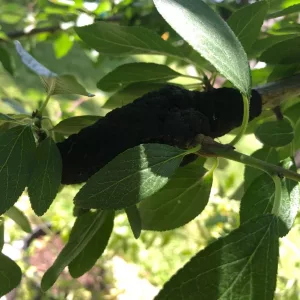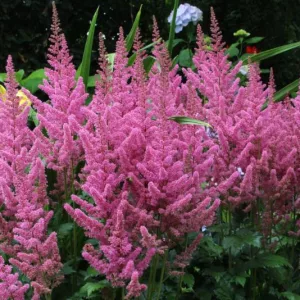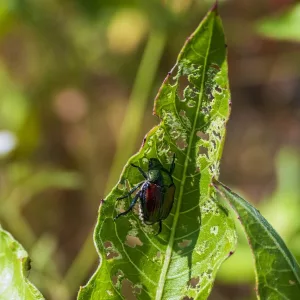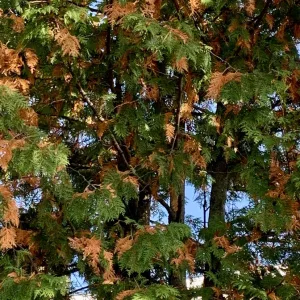By this time in the gardening season, I tend to get less questions about planting and more about plant disease. Lina was quite concerned about some unusual black growths on the stems of her plum tree. In the spring she had notice that there were some rough brown patches of bark on some stems. Now those areas have developed black growths. When I saw the pictures she had sent, I knew what the issue was.
Unfortunately, this is a very common fungal disease called Black Knot that is very harmful to plum trees. In our area, the disease spreads rampantly in bush areas that contain chokecherries. This is a native variety of cherry that is extremely susceptible to disease. Spores can travel long distances, carried by wind, to your plum trees.
Black Knot (Apiosporina morbosa) spores overwinter in the blackened “knots” of infected branches. Disease spores are spread to new hosts by wind during warm spring weather when there is rain or high humidity. Once the spores take hold, stem tissue does look rough, as Lina observed.
As the disease progresses, the bark splits, the tissue erupts with a corky appearance that eventually turns black. The eruption is when spores are released that can spread around the tree and to other branches and susceptible trees. At this point there is little option except to prune off affected branches.
Prune those affected branches back a minimum of 6” below the diseased tissue. Dip pruning tools in 70% rubbing alcohol between cuts to kill any fungal spores and prevent spreading this disease to healthy tissue. Be sure to either bag and discard diseased branches or burn them.
If the black knot erupts in the main trunk of the tree, the entire tree will have to be removed. We lost a beautiful ornamental Chokecherry to this disease. It was a sad day when the Shubert Chokecherry had to be cut down. I have notice that many Shubert Chokecherries were removed from commercial plantings along Great Northern Road in the past five years. Black Knot had spread throughout all those trees.
Unfortunately, the black knots may not be as noticeable in a mature tree or stands of shrubby chokecherry when it is in full leaf. However, this disease is very evident in late fall, winter, and early spring when the tree has no leaves at all.
If you plan to grow plum trees, it is always a good idea to do a bit of scouting first. Make sure none of your neighbours have an infected tree. Check the bush areas around your property for chokecherry too. Where they grow, Black Knot is sure to follow.
It is also a very good idea to regularly spray your fruit trees with lime sulphur. This fungicide will smother and kill any disease spores. The first application can be done at the end of March or early April on a mild day. It is a good idea to mix the lime sulphur with dormant oil, following the mixing rate on the packages. Dormant oil will smother any insect eggs that have over-wintered on your tree.
I would suggest following up with several more applications of lime sulphur throughout the spring and summer. This will help to prevent a disease from taking hold in your tree.
Another disease question that has come up lately has been about water-soaked brown and black spots on peony leaves. Botrytis blight is a common fungal disease that appears during periods of high humidity and frequent rainfall. It can also be spread throughout the plant if you tend to water the garden by wetting foliage instead of just the soil. Tender, newest tissue is commonly affected but sometimes entire stems will rot at the soil line.
Try to keep peony foliage dry when watering. During periods of high humidity and frequent rainfall, keep an eye on your plants and remove infected leaves quickly. Spray the rest of the plant with lime sulphur or dust with sulphur powder.
Unfortunately, Botrytis blight can infect many garden plants when weather is favourable for it to spread but in most cases, it does not kill a robust, healthy plant. Early detection is the key to saving a plant.




